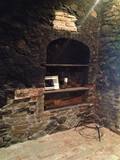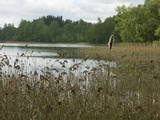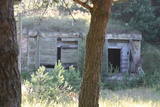| Nr | Name | Beschreibung |
|---|---|---|
|
The Jūrkalne People's Centre is the main gathering place for Suiti people and is in a former saloon that was built around 1875. Major restorations were conducted in 2011. The centre offers various events, there is an exhibition hall for visitors, and the "Maģie Suiti" ethnographic ensemble and other amateur ensembles are active there. If you want to meet the Suiti and learn about their traditions, contact the centre in advance. |
||
|
On the edge of the Bērzkrogs-Madona road in the centre of Vecpiebalga, you will find a pond full of various types of water lilies of different colours. The owner will tell you all about the popular folk song about water lilies from Vecpiebalga, offer plants for sale and offer practical advice. The pond also has carp which children can feed by hand while their parents are listening to the stories. |
||
|
Маршрут подходит для активных туристов, интересующихся многообразием природной и культурной среды национального парка «Кемери». Национальный парк «Кемери» (основан в 1997 г.) создан, прежде всего, для защиты водноболотных угодий – мелководного побережья Рижского залива, заросших прибрежных озер, болот, влажных лесов (трясин и др.) и пойменных лугов, как значимых мест произростания многих растений (~ 25 % от видов растений, занесенных в Красную книгу Латвии) и обитания животных, особенно мест скопления гнездящихся и перелетных птиц. На территории парка находится один из крупнейших заболоченных массивов Латвии – Большое Кемерское болото. Заболоченные массивы являются значимым местом образования и выхода сероводородных вод, а также местонахождения лечебных грязей, используемых в медицине, которые в свое время послужили основанием для создания известного курорта «Кемери». Информация о маршруте от Latvijas Lauku forums |
||
|
Redāns ir 19. gadsimta beigās celtā Liepājas Jūras cietokšņa daļa, kur notikušas Latvijai nozīmīgas cīņas. Lai gan uzbūvētie nocietinājumi ap Karostu tika atzīti par stratēģisku kļūdu un vairums no tiem saspridzināti, Redāns palicis teju neskarts. Tā ir arī vienīgā nocietinājuma daļa, kur notikusi reāla karadarbība.Par liecina ložu šautie caurumi sienās. 1919. gada 14. novembrī šeit notika brīvības cīņas par neatkarīgu Latviju, aizstāvot Liepāju pret Bermonta karaspēku. 14. novembra rītā, pārejot aizsalušo Tosmares ezeru, bermontiešu kājnieki ieņēma Redānu. Taču dažu stundu laikā liepājnieki veica niknu pretuzbrukumu, un vāciešiem nācās atkāpties. Jūnijā, jūlijā un augustā katru dienu plkst. 11.00–17.00 pie Redāna gaidīs zinošs gids, kas būs gatavs pastāstīt vairāk par Liepājas cietoksni un vēsturiskajiem notikumiem Karostā. Cena – 2 EUR no personas. |
||
|
Das Restaurant befindet sich am Schokoladenmuseum in Pure. Aus der Terrasse bietet sich eine weite Aussicht auf das Urstromtal des Flusses Abava. Die Speisekarte wird hier abhängig von der Saison und der Anfrage geändert. Lettische Küche: Kalte Suppe, Ampfersuppe, geschmorte grüne Erbsen und Karotten, Leber-Stroganoff, Haferflocken-Dessert, Milchkompott mit Beerensoße. Das besondere Gericht: Gerichte mit Produkten und Zutaten von Pure Chocolate. |
||
|
Matsalu muiža pirmoreiz vēsturiskajos avotos ir minēta 1560. g., kad tā ietilpa Lihulas bīskapijas sastāvā. Tagad redzamās ēkas ir celtas laikā no 18. gs. otrās puses līdz 20. gs. sākumam. Pagājušā gadsimta sešdesmitajos gados te plānoja izveidot Matsalu rezervāta centru, taču „veiksmīgā loze” tika netālu esošajai Penijē muižai (sk. iepriekš). Mūsdienās muižas pils, citas ēkas un parks (tajā dīķis ar salu) atrodas kritiskā stāvoklī. Taču kā nozīmīgu vēstures liecinieku arī šo muižu var iekļaut apskatāmo objektu sarakstā. Muižas komplekss atrodas pa ceļam uz Kēmu (Keemu) putnu vērošanas torni. |
||
|
Atrodas Rīgas ielā 39. Dievnams celts 1848. – 1849. g. klasicisma stilā (arhitekts A. Štauberts), bet laikā no 1924. – 1934. g. pārbūvēts (A. Vizuļa projekts). Dievnama izskatu salīdzina ar Svētā Pētera katedrāles veidolu Vatikānā. Blakus baznīcai atrodas Rīgas ielas gājējiem domātā daļa. |
||
|
The farm uses ancient recipes from grandmothers to bake aromatic sourdough and rye bread on maple leaves, with the crunch crust being processed with flax oil. You can help to bake the bread and then taste and buy it. |
||
|
Ogu un augļu dārzs, dažādu ievārījumu, sulu, sīrupu ražošana un tirdzniecība.
|
||
|
Ilzenbergas ist der erste und größte landwirtschaftliche Gutshof im Baltikum. In der Wirtschaft, die in Harmonie mit der Natur betrieben wird, kann man verschiedene Sauerteigbrote kosten und kaufen, Geflügel, Eier, Fleisch von auf ökologischen Weiden gehaltenem Rind, Milch und Milchprodukte, Fisch aus den eigenen Fischteichen, Obst und Gemüse, Honig aus der maximal ökologischen Umgebung des Gutes, verschiedene geräucherte, getrocknete und sauer eingelegte Produkte. |
||
|
Atrodas Skuķu ezera ziemeļaustrumu krastā. No torņa labi saskatāms aizaugušais Skuķu ezers ar nelielām ūdens lāmām un ūdeņiem bagātos pavasaros pārplūstošā Dvietes paliene. Laba putnu vērošanas vieta. |
||
|
Found in the Alsunga Museum, this workshop demonstrates how the folk costumes and accessories of the Suiti community are produced. Visitors can learn about weaving traditions in the area and examine the colourful range of folk costumes. Visitors are welcome to try their hand at the work under the guidance of experienced specialists. |
||
|
Atrodas t.s. Baznīcu kalnā – 18. novembra ielā 66. Apjoma ziņā – lielākais Daugavpils luterāņu dievnams, kuru cēla laikā no 1891. - 1893. g. neogotiskā stilā no sarkanajiem ķieģeļiem (arhitekts Vilhelms Neimanis). 1941. g. baznīcā izcēlās ugunsgrēks un gāja bojā lielākā daļa no tās sākotnējās iekārtas. Turpmāko divu gadu laikā baznīcu daļēji atjaunoja, taču vēlāk tajā izveidoja noliktavu u.c. baznīcai „nepiederīgas” iestādes. 1985. g. ēka vēlreiz cieta ugunsgrēkā. Pagājušā gadsimta deviņdesmito gadu sākumā uzsāka baznīcas atjaunošanas darbus, uzstādīja solus un altāri, kas ir Ogres Amatniecības vidusskolas audzēkņu darinājums. |
||
|
Im bäuerlichen Betrieb werden Ziegen gezüchtet und Gemüse angebaut. Exkursion zum Hof, Teilnahme am Melken von Ziegen, Verkostung und Erwerb von Käse, Brot und gefüllten Teigtaschen. Teilnahme an der Herstellung von Käse. |
||
|
Erholungskomplex "Lejasmalas" befindet sich auf dem Ufer des Sees Lejas mit einem schönen Blick auf die Inseln. Lettgallische Gerichte aus den selbs angebauten Produkten. Lettische Küche: Gericht Buļbešnīki (auch mit Karotten), sieben Käsesorten, hausgemachte Würste (gekochte, gebratene, Blutwürste), Gericht Sekonkas (warmes Gericht aus Schweineorganen), Fischsuppe, geräucherte Fische, gefüllte Hechte, Fischfrikadellen, Birkensäfte, Hausbranntwein. Das besondere Gericht: Klöße von Aulejas. |
||
|
This park was set up to protect the lovely ancient valley of the Dubysa River. This is one of the most popular rivers for water tourism in Lithuania, because it has a significant drop with rapids and beautiful shorelines.
|
||
|
Vairākas salas Zvirgzdenes ezerā, uz kurām saglabājušies platlapju (ozolu, liepu) meži ar bagātīgu zemsedzes floru. Salas var redzēt no ceļiem, kas piekļaujas ezera ziemeļu un austrumu krastam. |
||
|
Familienrestaurant, Hotel, Fahrradverleih 4 km von Piņķi, 12 Minuten Autofahrt vom Flughafen Riga entfernt. Ein Team von 12 professionellen Köchen bereitet eine große Auswahl an Gerichten zu. Vollständiges Menü: facebook.com/irbenilv/menu. Auch zum Mitnehmen. Für Gruppen von mehr als 10 Personen wird eine vorherige Anmeldung empfohlen. |
||
|
In der Zeit der Sowjetunion war die Aufgabe der Armeebrigade 77 für Zenitraketen die erfolgreiche Flugabwehr an der äußeren Grenze der UdSSR. Zur Zeit ist das Objekt im Besitz von der Selbstverwaltung des Gebietes. Das Objekt ist verlassen, nicht bewacht und es wird nicht genutzt. Am Haupteingang der Station der Raketen ist ein interessantes Tor erhalten geblieben.
|
||
|
Biškopības produktu ražošana - medus, ziedputekšņi, bišu maize, propoliss, bišu māšu peru pieniņš. Bišu māšu selekcija, bišu saimes. |
||

























